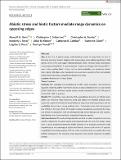Files in this item
Abiotic stress and biotic factors mediate range dynamics on opposing edges
Item metadata
| dc.contributor.author | Sirén, Alexej P. K. | |
| dc.contributor.author | Sutherland, Christopher S. | |
| dc.contributor.author | Bernier, Christopher A. | |
| dc.contributor.author | Royar, Kimberly J. | |
| dc.contributor.author | Kilborn, Jillian R. | |
| dc.contributor.author | Callahan, Catherine B. | |
| dc.contributor.author | Cliché, Rachel M. | |
| dc.contributor.author | Prout, Leighlan S. | |
| dc.contributor.author | Morelli, Toni Lyn | |
| dc.date.accessioned | 2021-04-06T09:30:14Z | |
| dc.date.available | 2021-04-06T09:30:14Z | |
| dc.date.issued | 2021-04-05 | |
| dc.identifier | 273660106 | |
| dc.identifier | 12e985da-53a1-4897-bc5a-2598f2255116 | |
| dc.identifier | 85103564927 | |
| dc.identifier | 000636715100001 | |
| dc.identifier.citation | Sirén , A P K , Sutherland , C S , Bernier , C A , Royar , K J , Kilborn , J R , Callahan , C B , Cliché , R M , Prout , L S & Morelli , T L 2021 , ' Abiotic stress and biotic factors mediate range dynamics on opposing edges ' , Journal of Biogeography , vol. Early view . https://doi.org/10.1111/jbi.14112 | en |
| dc.identifier.issn | 0305-0270 | |
| dc.identifier.other | RIS: urn:443941BBD1C4CB695EA95DCEAE8A9195 | |
| dc.identifier.other | ORCID: /0000-0003-2073-1751/work/92020367 | |
| dc.identifier.uri | https://hdl.handle.net/10023/21772 | |
| dc.description | This research was funded by the U.S. Department of the Interior Northeast Climate Adaptation Science Center, which is managed by the U.S. Geological Survey National Climate Adaptation Science Center. Additional funding was provided by T‐2‐3R grants for Nongame Species Monitoring and Management through the New Hampshire Fish and Game Department (NHFG), and E‐1‐25 grants for Investigations and Population Recovery through the Vermont Fish and Wildlife Department (VFWD). | en |
| dc.description.abstract | Aim In the face of global change, understanding causes of range limits are one of the most pressing needs in biogeography and ecology. A prevailing hypothesis is that abiotic stress forms cold (upper latitude/altitude) limits, whereas biotic interactions create warm (lower) limits. A new framework - Interactive Range-Limit Theory (iRLT) - asserts that positive biotic factors such as food availability can ameliorate abiotic stress along cold edges, whereas abiotic stress can have a positive effect and mediate biotic interactions (e.g., competition) along warm limits. Location Northeastern United States Taxon Carnivora Methods We evaluated two hypotheses of iRLT using occupancy and structural equation modeling (SEM) frameworks based on data collected over a 6-year period (2014?2019) of six carnivore species across a broad latitudinal (42.8-45.3°N) and altitudinal (3-1451 m) gradient. Results We found that snow directly limits populations, but prey or habitat availability can influence range dynamics along cold edges. For example, bobcats (Lynx rufus) and coyotes (Canis latrans) were limited by deep snow and long winters, but the availability of prey had a strong positive effect. Conversely, snow had a strong positive effect on the warm limits of Canada lynx (Lynx canadensis), countering the negative effect of competition with the phylogenetically similar bobcat and with coyotes, highlighting how climate mediates competition between species. Main conclusions We used an integrated dataset that included competitors and prey species collected at the same spatial and temporal scale. As such, this design, along with a causal modeling framework (SEM), allowed us to evaluate community-wide hypotheses at macroecological scales and identify coarse-scale drivers of species' range limits. Our study supports iRLT and underscores the need to consider direct and indirect mechanisms for studying range dynamics and species' responses to global change. | |
| dc.format.extent | 15 | |
| dc.format.extent | 2465749 | |
| dc.language.iso | eng | |
| dc.relation.ispartof | Journal of Biogeography | en |
| dc.subject | Abiotic stress | en |
| dc.subject | Biotic interactions | en |
| dc.subject | Carnivores | en |
| dc.subject | Climate change | en |
| dc.subject | Competition | en |
| dc.subject | Range limits | en |
| dc.subject | Snow | en |
| dc.subject | Structural equation modeling | en |
| dc.subject | GE Environmental Sciences | en |
| dc.subject | QH301 Biology | en |
| dc.subject | DAS | en |
| dc.subject | SDG 13 - Climate Action | en |
| dc.subject.lcc | GE | en |
| dc.subject.lcc | QH301 | en |
| dc.title | Abiotic stress and biotic factors mediate range dynamics on opposing edges | en |
| dc.type | Journal article | en |
| dc.contributor.institution | University of St Andrews. Statistics | en |
| dc.contributor.institution | University of St Andrews. Centre for Research into Ecological & Environmental Modelling | en |
| dc.identifier.doi | https://doi.org/10.1111/jbi.14112 | |
| dc.description.status | Peer reviewed | en |
This item appears in the following Collection(s)
Items in the St Andrews Research Repository are protected by copyright, with all rights reserved, unless otherwise indicated.

